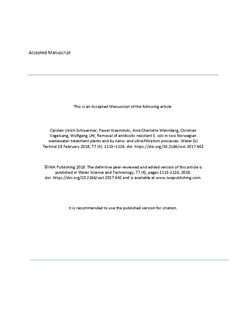| dc.contributor.author | Schwermer, Carsten Ulrich | |
| dc.contributor.author | Krzeminski, Pawel | |
| dc.contributor.author | Wennberg, Aina Charlotte | |
| dc.contributor.author | Vogelsang, Christian | |
| dc.contributor.author | Uhl, Wolfgang | |
| dc.date.accessioned | 2019-05-29T08:06:11Z | |
| dc.date.available | 2019-05-29T08:06:11Z | |
| dc.date.created | 2018-01-03T13:47:16Z | |
| dc.date.issued | 2018 | |
| dc.identifier.citation | Water Science and Technology. 2018, 77 (4), 1115-1126. | nb_NO |
| dc.identifier.issn | 0273-1223 | |
| dc.identifier.uri | http://hdl.handle.net/11250/2599363 | |
| dc.description.abstract | The effectivity of different treatment stages at two large wastewater treatment plants (WWTPs) located in Oslo, Norway, to remove antibiotic resistant Escherichia coli from municipal wastewater was investigated. The WWTPs were effective in reducing the total cultivable E. coli. The E. coli in WWTP samples were mainly resistant to ampicillin (6–27%) and trimethoprim-sulfamethoxazole (5–24%), and, to a lesser extent, tetracycline (3–14%) and ciprofloxacin (0–7%). In the first WWTP, a clear decrease in the percentage of E. coli resistant to these antibiotics was found, with the main removal occurring during physical/chemical treatment. In the second WWTP, the percentage of cultivable resistant E. coli did not display a considerable change. During laboratory-scale membrane filtration of WWTP effluents using ultrafiltration (UF) and nanofiltration (NF) membranes, all E. coli, including those resistant to antibiotics, were removed completely. The results imply that UF and NF processes are potent measures to remove antibiotic resistant bacteria (ARB) during post-treatment of WWTP effluents, thus reducing the potential spread of antibiotic resistance in the receiving aquatic environment. | nb_NO |
| dc.language.iso | eng | nb_NO |
| dc.publisher | IWA Publishing | nb_NO |
| dc.relation.uri | http://wst.iwaponline.com/content/77/4/1115 | |
| dc.title | Removal of antibiotic resistant E. coli in two Norwegian wastewater treatment plants and by nano- and ultra-filtration processes | nb_NO |
| dc.type | Journal article | nb_NO |
| dc.type | Peer reviewed | nb_NO |
| dc.description.version | acceptedVersion | nb_NO |
| dc.source.pagenumber | 1115-1126 | nb_NO |
| dc.source.volume | 77 | nb_NO |
| dc.source.journal | Water Science and Technology | nb_NO |
| dc.source.issue | 4 | nb_NO |
| dc.identifier.doi | 10.2166/wst.2017.642 | |
| dc.identifier.cristin | 1534897 | |
| dc.relation.project | Norges forskningsråd: 208430 | nb_NO |
| cristin.unitcode | 7464,20,16,0 | |
| cristin.unitname | Systemer og teknologi | |
| cristin.ispublished | true | |
| cristin.fulltext | postprint | |
| cristin.qualitycode | 2 | |
